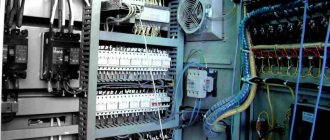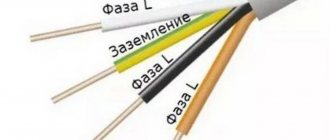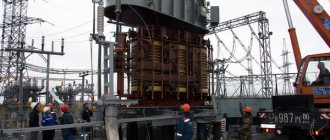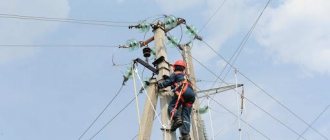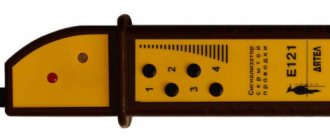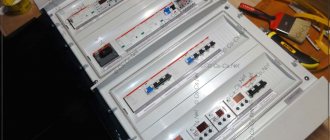Installation of electrical equipment is a set of actions for its installation and connection to electrical networks, carried out in accordance with the project. Electrical installation may involve laying cable lines, installing distribution lines and transformers, installing wiring, various electrical power plants and other equipment. Even the most modern equipment with excellent reliability and safety indicators can be damaged by errors during its installation and commissioning.
Therefore, in order for the operation of electrical equipment to proceed uninterruptedly and as efficiently as possible, its installation and commissioning must be carried out by specialized organizations that have licenses and permits to provide such services. Electrical installation carried out at a high professional level is the basis for safe operation of the facility and stable operation of the equipment.
Stages of installation of electrical equipment
Installation of electrical equipment at an enterprise or other facility includes:
- Preparatory stage - preparation of wiring units and lighting lines, preparation of routes for laying wires and grounding elements, installation of embedded parts for further fastening of equipment. These works are carried out simultaneously with construction and finishing activities.
- Laying cables and wiring along prepared routes, with serial connection. In industrial premises, this work is carried out in parallel with the installation of electrical equipment.
- Carrying out electrical measurements and insulation resistance measurements. Preparation of a technical report.
- Performing commissioning work:
- study of design and technical documentation;
- checking the readiness of electrical equipment for commissioning;
- searching for faults that occurred during installation;
- startup of electrical installation;
- adjustment of electrical equipment;
- preparation of the Equipment Acceptance Certificate and technical report.
When carrying out installation work, it is important to comply with all the requirements of current regulatory documents (PUE, SNIP, PTE, TNP, PTB). It is also necessary to strictly follow the decisions and parameters specified in the project and technical documentation, and strictly adhere to the installation requirements set out in the instructions for the equipment.
Why do you need to check electrical installations?
In addition to the correct installation of electrical equipment, it is important to take care of checking all its parameters to confirm the correctness of the chosen solutions. These functions perform commissioning work, during which a complete check of electrical installations is carried out for compliance with safety standards and declared parameters. This work is performed by highly qualified specialists who are able to draw correct conclusions and eliminate detected inconsistencies.
During operation, electrical equipment wears out, resulting in an increased risk of its breakdown and electric shock to people. Periodic inspections of electrical installations help monitor the wear and tear of equipment and prevent emergency situations, production stoppages, huge costs for restoring failed equipment and the payment of fines.
Electrical laboratory "Energoservice 2.0" provides professional services for the installation of electrical equipment, as well as checking commissioned and used electrical installations for compliance with current standards and regulations.
Saving on periodic inspection of electrical installations is dangerous and unprofitable, because the costs of eliminating the consequences of an accident are much higher than the cost of services to identify equipment defects.
Installation of industrial electrical equipment
Installation of industrial electrical equipment is a responsible and labor-intensive process that requires a professional approach at all stages. Violations during transportation and unloading of equipment, as well as errors in design and installation, negatively affect the operation of electrical installations and can ultimately lead to an accident. To prevent such consequences, the installation of electrical equipment must be entrusted to competent specialists who guarantee high-quality performance of work of any complexity.
The engineer installs electrical equipment in facilities for various purposes - from residential and administrative buildings to shopping, entertainment and office centers, warehouses and industrial enterprises. We fulfill our obligations professionally, on time and in full accordance with the concluded contract.
Projects are compiled in accordance with customer requirements, operating standards and safety regulations. All work is carried out by experienced electricians with the necessary approvals, using certified components and installation devices from leading manufacturers.
1. Study of design and estimate documentation for the electrification of enterprise facilities (constructed and newly built).
For each construction project, design and estimate documentation is developed, in accordance with which construction work is carried out on the construction of buildings and structures, installation of technological, sanitary and electrical equipment, automation, communications, etc.
Working drawings for the construction of industrial enterprises consist of sets of architectural - construction, sanitary - technical, electrical and technological drawings.
A set of electrical engineering working drawings contains the documentation necessary for the installation of external and internal electrical networks, substations and other power supply devices, power and lighting electrical equipment. When accepting working documentation for the execution of work, it is necessary to check that it takes into account the requirements for the industrialization of the installation of electrical devices, as well as the mechanization of work on laying cables, rigging components and blocks of electrical equipment and their installation.
Directly at the site of installation of equipment and laying electrical networks in workshops, buildings (in the installation area), installation work should be reduced to the installation of large blocks of electrical devices, assembling their components and laying networks.
In accordance with this, working drawings are completed according to their purpose: for procurement work, i.e. for ordering blocks and assemblies at enterprises or at assembly and assembly plants, installation organizations and in workshops of electrical installation workpieces (EPW), and for installation of electrical devices in the assembly room zone.
The projects provide for the maximum exclusion of hole-punching work at the installation site.
For the installation of power electrical equipment, floor plans of buildings and workshops are developed, indicating and coordinating on them the routes for laying supply and distribution power networks and the placement of busbars, power supply points and cabinets, electrical receivers and ballasts. To install electric lighting, floor plans of buildings and workshops are made, indicating and coordinating supply and group lighting networks, lamps, points and switchboards.
Develop basic and design diagrams of power and lighting equipment.
The customer provides the installation organization with installation and assembly drawings, diagrams and installation instructions also received from the manufacturer with the equipment.
2. Installation of hidden and open lighting wiring on various bases with wires and cables;
Installation of open lighting electrical wiring.
How is outdoor electrical equipment installed?
When it comes to substations, many factors are taken into account when forming them. Of course, you need to have an idea of what voltage will be supplied to such a device and what current characteristics should be obtained as a result. However, you should also know what the power of the object or group of objects that will be connected to such a substation will be. Currently, there are two approaches to creating equipment for trunk lines. The first involves the creation of substations according to an individual project, which requires a long time and high costs. Therefore, in practice, the installation of complete substations assembled at the factory is much more often used. An example of such a device is shown in the following photo.
Next, you need to decide whether the cable will be laid along an overpass, underground or on supports. Also, during installation you will have to comply with a number of requirements. In particular, the substation should always be located on a level surface. Metal channels used as a base must deviate from the required level by no more than 1 mm/meter, or 5 millimeters along the entire length of the device. If it is necessary to obtain a very powerful device, complete substations can be connected to each other by special buses, which makes it possible to obtain a single circuit.
Why should only a specialist install electrical equipment?
Any equipment for electrical networks, regardless of its purpose, has a rather complex structure. Therefore, its connection can only be carried out by a person who has an understanding of the basic principles of electrical engineering, as well as the structure of the specific electrical network with which the work will be carried out.
In addition, if we are talking about transformer and distribution substations, most likely, you will have to work with increased voltage, capable of reaching 6-35 kV. Such electric current can cause significant damage to human health, including irreparable damage. Therefore, any repair and installation work related to high-power electrical equipment must be carried out by a qualified specialist wearing protective equipment.
Below you can use the online calculator to calculate the cost of electrical installation work.
Installation nuances
Electrical installation work begins with planning. The main task is to find a rational installation option. The complex amount of work begins with drawing up a network schedule. It indicates the list of work that needs to be performed, the sequence and duration of completion, and their relationship. After approval of the network schedule, electrical equipment installers begin work.
In the case of carrying out work on the power supply of an apartment, private house, office or other objects, first of all the circuit diagram is studied. Next, all the necessary system components are purchased and delivered to the work site, the technology for installing electrical equipment, the necessary tools and control devices are selected.
In an apartment or private house, household equipment is connected taking into account its energy consumption. In addition, you must adhere to these basic rules:
- wires are laid only horizontally and vertically;
- electricity meters, switches, sockets, distribution boxes and equipment must be installed so that they are easy to maintain;
- the number of sockets must be at least 1 for every 6 m2 of room, in the kitchen - at least 3, regardless of its area;
- connections and branches of wires must be mounted in junction and branch boxes;
- A separate line is installed to power powerful electrical equipment.
Full range of electrical installation services
To calculate a preliminary estimate, it is necessary for our experienced foreman to come to the site.
He will take all the necessary measurements and advise the client on related issues on the spot. During the preparatory stage, the condition of the premises is assessed and, if necessary, old wiring is dismantled. Engineers develop a draft equipment connection diagram, select tools and purchase materials necessary to complete the work.
The main stage of installation of electrical equipment includes arrangement of the internal grounding loop, assembly and installation of electrical panels, connection of contact wires, preliminary work on putting devices powered from the mains into operation.
The installation is completed by testing the performance of the equipment. During the commissioning process, the slightest deficiencies are identified; if any are found, they are immediately eliminated.
provides a full range of turnkey installation services for electrical equipment:
- gating, installation of boxes and laying of power cables;
- installation of electrical panels and transformers;
- installation of circuit breakers and RCDs;
- installation of technological lines;
- electrical installation in buildings with wooden walls or flammable finishes;
- modular grounding;
- design of electrical wiring systems for connecting powerful equipment;
- installation of electricity meters and generators;
- installation and connection of production conveyor lines, industrial machines, etc.
Electric motor installation technology
The engine can be delivered to the installation site directly from the manufacturer, from the warehouse and after repair work. It can be installed on a steel or cast iron plate, a welded metal frame, a special slide or bracket. All these elements must be aligned along the axes of the engine installation in a horizontal plane and secured with foundation bolts. Holes for them are usually made during construction work, if this is provided for in the working design. In this case, plugs made of wood are left in the required places in advance.
Installation of power electrical equipment
Power electrical equipment is low- and high-voltage devices, lines and auxiliary products designed for the production, transformation, transmission, distribution and conversion of electrical energy into the required type of energy. According to their intended purpose, power plants can be domestic or industrial. They are also characterized by voltage - up to 1000 V and higher. They can be stationary or mobile. By design, they can be complete or individual. According to location - free-standing and built-in.
All of them pose a danger to humans if handled improperly. Their installation must take into account special requirements. They can be installed on existing facilities, newly built ones, or under renovation. Installation of power electrical equipment should only be carried out by electricians who specialize in a particular type of installation. The list of works they carry out is quite extensive:
- installation of power lines;
- installation of internal power supply systems;
- installation of floor and individual switchboards, input distribution devices, distribution points;
- installation of electric lighting products and equipment indoors and outdoors;
- installation of transformer substations;
- installation of backup power supplies;
- connecting various equipment to electrical networks of energy transmission companies.
Features of dismantling electrical equipment
Work related to the dismantling of electrical equipment is considered to be of increased danger. Such work is performed in case of breakdown, failure of products or when replacing obsolete equipment with more modern models. The electrician must have permission to work under voltage and with electrical equipment. He must be able to use special equipment, tools and instrumentation.
The work is performed in the following sequence:
- disconnect the product from the power source;
- disconnected from the grounding circuit;
- removed from the base by unscrewing the fasteners.
The technology of dismantling, as well as installation, depends on the design of the electrical equipment. Typically, instructions for dismantling electrical equipment are specified in the operating instructions that the manufacturer encloses with the product, and which the enterprise or institution must keep until written off.
Types of electrical installations
There are 5 types of electrical installations that are most often encountered in practice:
- industrial installations that ensure the operation of pumps, compressors, ventilation units and similar equipment;
- AC converters;
- installations for electrothermal operations and arc furnaces;
- installations for electric welding with an uneven load cycle;
- electric lighting installations.
The reliability category of electrical installation equipment depends on the load distribution across phases. The highest degree, third, is required for electric welding installations. For current converters and electrothermal complexes, the second degree is sufficient. The remaining electrical installations, due to the symmetrical uniform distribution of loads, belong to the first reliability category.
